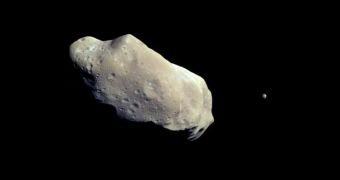California Institute of Technology (Caltech) scientists are a quirky bunch, as demonstrated by a recent workshop they held, assessing the challenges associated with capturing a near-Earth asteroid from its peaceful orbit, and dragging it closer to our planet.
The goal of doing this – other than to prove that we can – is to use that asteroid as a stepping stone for future space exploration missions that would take astronauts deeper into space than ever before.
The space rock could be outfitted with refueling stations and other amenities that would make it easier for ships to travel throughout the solar system. An asteroid would supply a much firmer base of operations than a man-made facility such as the International Space Station (ISS).
Conceivably, the rock would also provide enough room to allow the construction of space docks that could be used to put ships together. Even if that is not possible, the fact remains that it would be a lot simpler to launch missions from Earth if they did not have to carry everything they needed with them.
At this point, a spacecraft needs to carry all fuel, water and energy it will require. But that could change if these supplies were to be stocked on an asteroid. According to the conclusions of the Caltech workshop, fetching such a base of operations is a lot simpler than it sounds.
An asteroid can be captured with existing capabilities and experts present at the meeting estimate that a large, nickel-iron space rock could be placed in Earth's orbit in about 10 years. Harpoons, claws and magnets are just some of the means a spacecraft can use to capture an asteroid.
“Once you get over the initial reaction – 'You want to do what?! – it actually starts to seem like a reasonable idea,” NASA Jet Propulsion Laboratory (JPL) engineer and workshop organizer John Brophy explains. The JPL is a division of Caltech.
Experts at the meeting said that a captured asteroid could be stored in a Lagrangian point between the Earth and the Sun, which is a gravitationally-neutral location. What this means is that the object will always remain in the same relative position in respect to both the Sun and our planet.
In addition to the solid foundation they offer, space rocks can also be mined for resources, including iron, nickel, water and regolith. Frozen water could be split into hydrogen and oxygen via the process of hydrolysis, and the chemicals used for creating breathable air and rocket fuel.
Ultimately, having access to a nearby asteroid could help us practice space travel, preparing us for larger-scale efforts, aimed at our solar system's gas giants, Kuiper Belt-based dwarf planets and beyond, Wired reports.

 14 DAY TRIAL //
14 DAY TRIAL //